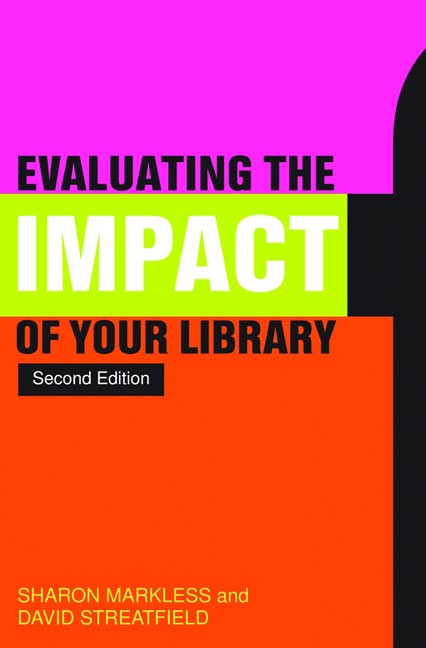Book contents
- Frontmatter
- Dedication
- Contents
- Introduction
- About the authors
- Impact and all that: use of some key terms in this book
- Part 1 The Context
- Part 2 Evaluating Impact
- 4 Putting the impact into planning
- 5 Getting things clear: objectives
- 6 Success criteria and impact indicators: how you know you are making a difference
- 7 Making things happen: activities and process indicators
- 8 Thinking about evidence
- 9 Gathering and interpreting evidence
- 10 Taking stock, setting targets and development planning
- Part 3 The Bigger Picture
- References
- Notes
- Index
- Evaluating and Measuring the Value, Use and Impact of Digital Collections
- Measuring Library Performance
- Miscellaneous Endmatter
10 - Taking stock, setting targets and development planning
from Part 2 - Evaluating Impact
Published online by Cambridge University Press: 08 June 2018
- Frontmatter
- Dedication
- Contents
- Introduction
- About the authors
- Impact and all that: use of some key terms in this book
- Part 1 The Context
- Part 2 Evaluating Impact
- 4 Putting the impact into planning
- 5 Getting things clear: objectives
- 6 Success criteria and impact indicators: how you know you are making a difference
- 7 Making things happen: activities and process indicators
- 8 Thinking about evidence
- 9 Gathering and interpreting evidence
- 10 Taking stock, setting targets and development planning
- Part 3 The Bigger Picture
- References
- Notes
- Index
- Evaluating and Measuring the Value, Use and Impact of Digital Collections
- Measuring Library Performance
- Miscellaneous Endmatter
Summary
This chapter starts by looking at how to review the impact indicators generated through the process in order to keep the whole thing manageable! We then focus on setting realistic impact targets and conclude by considering where and how development planning fits into the process of evaluating impact.
Taking stock: reviewing your impact and process indicators
Before you move on to select your targets, it will be useful to stop and review all your impact indicators. There are four main dimensions:
Range. Do your indicators reflect the full range of what you are trying to change and give you enough of a picture of whether your services are working efficiently?
Number. Have you generated too many indicators? Publications on managing performance usually recommend 15–20 ‘key’ indicators (including both process and impact indicators), with any others considered as secondary. If you go much beyond that scale it becomes difficult to gain and retain an overall picture of what is going on. Too many indicators can also lead to diverting over-much energy into collecting evidence rather than running your service.
Relevance. Do all the indicators really tell you something useful and contribute to the overall picture? Are you still collecting ‘traditional’ performance data because you have always done so? Are any of your indicators only used as the basis for making management reports?
User focus/service focus. Do you have a balance between ‘outward-looking’ user-focused indicators and ‘inward-looking’ system enhancement indicators?
No matter how much care you take in writing and reviewing your indicators, they may not all work. All indicators ought to be regarded as provisional at the outset. They should be monitored to see if they are leading you to really useful information. If not, change them or ditch them.
Setting targets for impact
Impact targets aim at improving the effectiveness of the service; they focus on discernible differences in impact on people in significant areas of use of the service. They are different from process targets, which record what people have done. Impact targets can be concerned with the whole community served or parts of it. See also the definitions offered in ‘Impact and all that: use of some key terms in this book’ on page xv.
- Type
- Chapter
- Information
- Evaluating the Impact of Your Library , pp. 171 - 180Publisher: FacetPrint publication year: 2012



